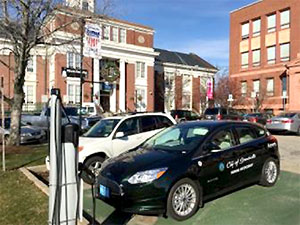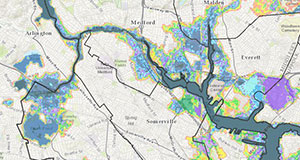
Several EV charging stations have been installed in the city to date, with even more hopefully on the way in the near future.
By Ian Erlichman
In 1630, most of East Somerville was coastline, and all of the Inner Belt District was completely submerged. According to National Geographic, this area and most all of Boston is built on trash, mud, and reallocated hills from the surrounding area.
The same article mentions that Boston rests on over 5,000 acres of man made land, more than any other U.S. city. That means Boston, and surrounding cities like East Somerville, are uniquely vulnerable to changes in water level. Confusingly, water table fluctuations in either direction, up or down, could spell trouble for America’s city on the hill.
But a group of five meet in City hall on the fourth Tuesday of every month to help solve that problem.
Somerville’s Energy Conservation Commission has received a grant of “$350,000, one of the highest in the whole program,” according to Oliver Sellers-Garcia, the Director of Sustainability and Environment, and leading member of the commission.
This newfound funding “will allow storm water drain modeling to be done at a higher resolution” with smaller drain pipes that allows for coverage of more streets said Director Sellers-Garcia. The commission will use this data to “look at the outputs of the model and issue early warnings for flood-affected neighborhoods,” he continued.
The model would also investigate the water filtration and absorption benefits of already present ecosystems, referred to as “green infrastructure.” A report on the benefits of green infrastructure in Somerville found that “the total computed benefit of trees in Somerville including both air pollution and storm water is $12,945,117.”
But the Somerville Energy Conservation Commission does much more than flood water analysis. The group worked to assess sources of carbon emissions in Somerville and brain stormed possible alternatives to carbon producing systems.
Soon, the final stage in Somerville’s Climate Forward Plan will be complete. The commission will release an “implementation heavy initiative” that sets concrete goals to move towards the city’s 2050 carbon neutrality goal, according to Director Sellers-Garcia

Management of the height of Somerville’s water table is a top priority for the Commission.
The aim to shrink carbon emissions in Somerville to a net-zero level by 2050 is a goal that Mayor Curtatone admitted may be called ambitious, according to the Sustainaville website. However, environmental prescience could prevent climate change effects like drought, more intense storms, and heightened sea level.
The effects of drought and heightened sea level hold special significance for low-elevation areas like East Somerville and Boston. These areas are built on man-made land, and more precisely, on tall subterranean stilts. When early Bostonians were expanding the surround coastline, they need something stiff to construct cites on: so, they used stilts. These underground poles are used to stabilize today’s buildings, linking surface structures to a sturdy layer of clay beneath shifting piles of mud and refuse.
Preserved from degradation by a buffer of water, if these century old stilts meet air, hungry bacteria would weaken their integrity and the surface buildings they support. However, some Somerville Citizens are working to prevent this.
The Energy Conservation Commission is attempting to stop extreme changes in the height of Somerville’s water table in either direction, both of which would result in disastrous structural damage to surface structures. Whether it be storm drain analysis and improvement, or trying to prevent the sweeping effects of climate change, this commission is staying true to its goal of “preserving and protecting Somerville’s natural environment.”
Because of that goal’s broadness and the commission’s relentless passion for preserving the environment, it tackles an even larger set of issues than those already mentioned. These include electric vehicle (EV) subsidies, EV charging stations, renter and landlord energy reform solutions, and green infrastructure.
On the automotive front, the commission is working on “getting EV charging stations in more residential areas” to meet the needs of Somerville’s burgeoning EV market. However, “we don’t want to put policies in place that separate more and more who get to have an electric vehicle,” noted Director Seller-Garcia
The group is also working to gather data and focus more programs on the renter demographic since “the commission has taken on a couple projects … and they’ve all been orientated toward a primarily owner-based population,” said one commission member. “Two thirds of units are renter occupied in the city and we wanted to come up with a suite of initiatives that target that population,” she continued.
Be sure to stop by the Energy Conservation Commission monthly meeting, held at Somerville City Hall, on the fourth Tuesday of every month, at 7:00 p.m.


















Reader Comments